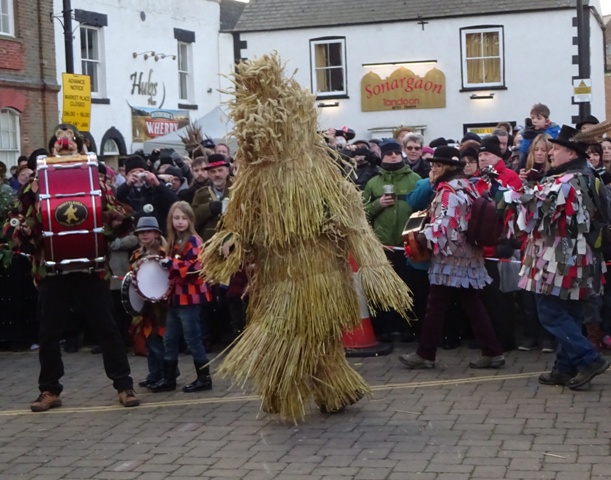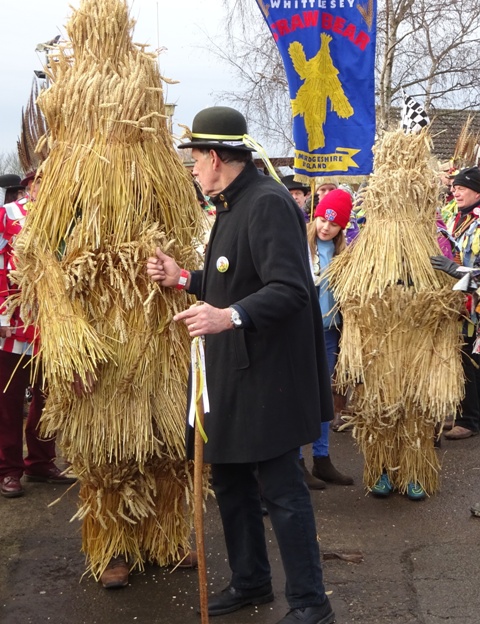Background to the Straw Bear Festival
The Straw Bear is a very old fenland icon which goes back well into the nineteenth century at the very least. Straw Bear parades took place on Plough Monday, the first Monday after Epiphany or Twelfth Night; the day when local farm workers were supposed to return to their work, ploughing the land.

The Straw Bear dances in the Market Place, Whittlesea January 2016
As they had not been working or paid during the Christmas holidays the agricultural workers and “ploughboys” toured the locality to perform molly dances, plough-plays or sing and entertain with acts of “mischief” and would beg for money. To avoid recognition, they would black their faces to disguise themselves as their aim was essentially to intimidate in order to obtain money: those refusing to donate would have some trick played upon them. In her book “Fenland Chronicle” (Sybil Marshall, 1963) she recounts that her mother, had told her “very often these were real nasty tricks, and they’d wait until Plough Monday to get their own back on somebody what had done them some injury during the year” for example, they would plough up a doorway or take gates off their hinges so that the livestock escaped.
The Straw Bear is not exclusively a Whittlesea custom and some of the earliest newspaper reports date from 1880 where in Ramsey, a few miles south of Whittlesea there are reports of an “individual dressed from top to toe in straw … (who) capered before the houses … to the merry strains of the accordion”.
Newspaper accounts of similar events continued until at least 1893 when a Mrs Edwards remembers her father being chosen to be the straw bear and seeing him bound with oat straw from head to foot. She recalls that the Straw Bear and Molly Dancers came from Ramsey and Walton (south of Ramsey) on Christmas Eve, but “the dancers cou’n’t be everywhere at once on one day, so they used to go about on any other special day to make up for it … from pub to pub and … any houses or cottages where they stood a chance o’ getting anything”. They were really interested in getting money but doubtless accepted food, mulled wine or beer.
In Whittlesea a 1882 newspaper records that on Straw Bear Tuesday or Straw Bower Day (just after Plough Monday) a man was dressed in straw and led dancing through the town “to entertain by his frantic and clumsy gestures the good folk who had on the previous day subscribed to the rustics, a spread of beer, tobacco and beef”. Regrettably, in 1909 an over enthusiastic Policeman decided that he would enforce the 1824 Vagrancy Act which outlawed “cadging” for subsistence and the Whittlesea customs were stopped.
Whittlesea’s German twin town, Walldurn, like many other European towns, also has a straw bear custom. The attendants of their straw bear are dressed in harlequin costume and can sometimes be seen amongst the crowds at Whittlesea. In Wurmlingen in 1852 the tradition incorporated the begging aspect of Plough Monday and other European festivals involve dressing up as wild men, other animals or in actual bearskins simulating the bears emerging from hibernation.
The Straw Bear tradition was revived in Whittlesea in 1980 and is now a weekend festival which this year celebrated its 40th Anniversary.

The 2019 Straw Bear begins his tour of Whittlesea
Dave Evans, Morris On! correspondent, January 2019
Sources
Based on an original article written by Gill Brett and published in Mardles Magazine in April 2016
Also;
Fenland Chronicle by Sybil Marshall; http://ramsey-and-district.ccan.co.uk/content/catalogue_item/history-of-ramsey-straw-bear ; Straw Bear Festival programme 2019; http://www.strawbear.org.uk/history-whittlesea-straw-bear-festival.html; https://en.wikipedia.org/wiki/Straw_bear

